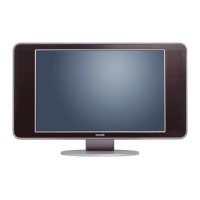
Do you have a question about the Philips LC4.2E and is the answer not in the manual?
| Display Technology | LCD |
|---|---|
| Screen Size | 42 inches |
| Aspect Ratio | 16:9 |
| Brightness | 500 cd/m² |
| Viewing Angle | 176° (Horizontal/Vertical) |
| Input Ports | Component, Composite |
| Sound Output | 2 x 10W |
Details the TV's visual and audio specifications, dimensions, and power requirements.
Illustrates and describes the various input and output connectors on the TV.
Critical safety regulations and precautions for performing repairs.
Important advisories regarding handling components and performing measurements.
Covers schematic notes, rework procedures, lead-free solder, and practical precautions.
Instructions on how to position the TV for service and disassembly.
Step-by-step instructions for removing the rear cover of the TV set.
Procedure for safely removing the power supply unit from the chassis.
Instructions for removing the main TV and Scaler board assembly.
Steps for removing the input/output (I/O) panel.
Procedure for removing the side I/O, keyboard, and front LED panels.
Instructions for removing the Pixel Plus panel module.
Steps for safely exchanging the main LCD panel.
General guidance for reassembling the TV set after repairs.
Identifies specific test points for measurements in service modes.
Explains Service Default Mode (SDM) and Service Alignment Mode (SAM).
Details the purpose and entry method for Service Default Mode.
Explains the purpose, specifications, and entry for Service Alignment Mode.
Describes Customer Service Mode for diagnostic information display.
Offers solutions for common picture and text issues encountered by users.
Introduces ComPair, a tool for service diagnostics and software management.
Details how to read and clear error codes from the error buffer.
Explains the different methods for viewing detected error codes.
Outlines the procedures for clearing the error code buffer.
Lists specific error codes and their descriptions for fault diagnosis.
Describes using the front LED to display error codes when there is no picture.
Provides general advice and tips for diagnosing and repairing faults.
Explains how to use the NVM Editor in SAM mode to modify NVM contents.
Procedure for loading default NVM values when the NVM is corrupted or blank.
Troubleshooting tips related to picture issues with RF input and tuner functionality.
Troubleshooting steps for video processing issues like no picture or comb filter problems.
Troubleshooting and testing procedures for the TV power supply unit.
Shows the LVDS connection wiring diagram for the 26-inch model.
Illustrates the signal flow for the tuner and IF video processing.
Details the functionality and connections of the video scaler IC.
Provides a layout of test points on the bottom side of the TV & Scaler board.
Shows the layout of test points on the top side of the TV & Scaler board.
Maps out the I2C bus interconnections between various ICs.
Diagrams the different power supply voltages distributed throughout the TV.
Circuit diagram for the tuner and IF video processing section.
Circuit diagram for the Hercules IC and its associated components.
Circuit diagram for the main power supply unit of the TV.
Circuit diagram detailing the functionality of the main scaler IC.
Circuit diagram for the EPLD control of the Pixel Plus panel.
Top-side component layout for the TV & Scaler board.
Circuit diagram for the rear I/O panel with SCART connectors (17").
Circuit diagram and layout for the front IR and LED panel.
Specifies the conditions required for performing electrical adjustments.
Details how to perform software alignments using the Service Alignment Mode (SAM).
Procedure for adjusting white balance and colour temperature.
Steps for adjusting the tuner's AGC and AFC settings.
Procedures for calibrating grey scale levels for SDTV, Analog PC, and HD inputs.
Explains how to change option bytes to control TV features and hardware.
Provides a high-level block diagram of the TV's main functional units.
Details the available input and output connectors and their functions.
Explains the function of the tuner and IF section, including sound decoding.
Covers TV part video processing and Scaler IC functions.
Explains the Pixel Plus functionality handled by EPLD for picture improvements.
Details the audio processing capabilities of the Hercules IC, including sound features.
Explains the roles of the micro-controllers on the system board.
Provides internal block diagrams and pin layouts for key ICs.
Lists parts specific to different screen sizes and their order codes.
Lists parts for the TV Scaler Board, including various components like capacitors and resistors.
Lists parts specific to the Pixel Plus panel.
